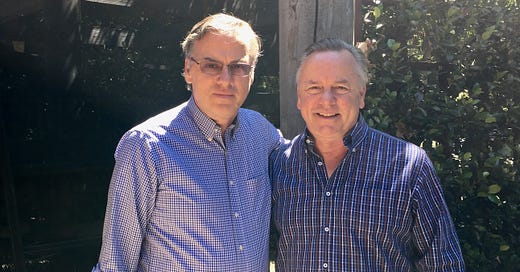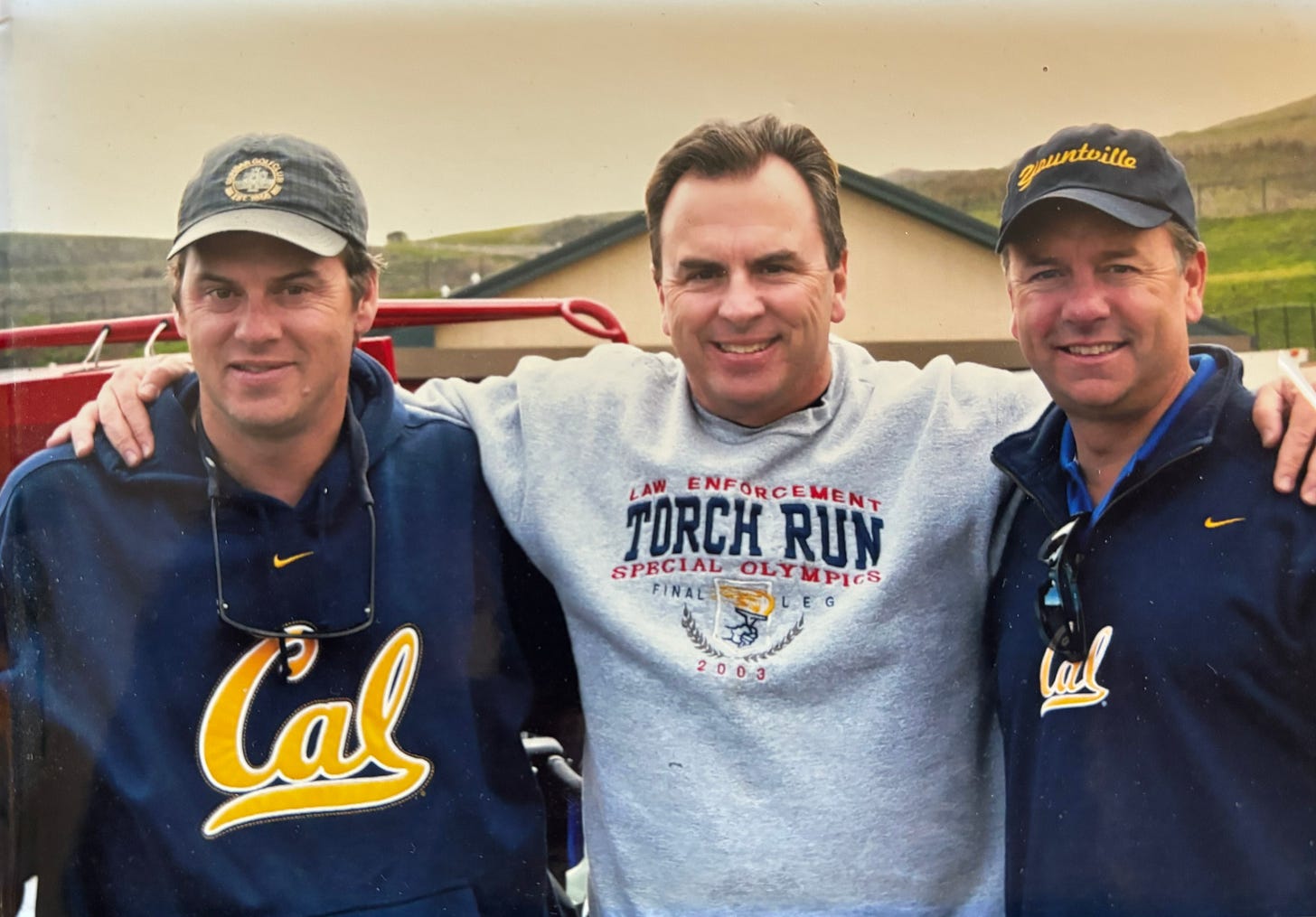NAPA VALLEY, Calif. — End-of-life planning should not be put off. Difficult as it is to discuss, none of us knows when our final days are coming.
This past February my brother, Michael, assigned me as his agent to manage his life. A 22-year brain cancer survivor, his body was in decline, and he was experiencing growing physical and cognitive deficits. He had lived two decades longer than the average length of survival since his diagnosis.
Mike had good days, when he could carry on a limited but understandable conversation. He also had bad days, when he mostly slept and could only offer one- or two-word responses to questions or during conversation. That was when it was clearest that he needed my help and support beyond being his younger brother.
As my brother’s medical condition declined rapidly in his final days, I followed Mike’s Advanced Health Care Directive regarding lifesaving medical treatments, his desired plans for his remains and other personal details to be followed after his death.
On June 19, I received a call from a staffer at Mike’s skilled nursing facility in Walnut Creek who said he was being transported by ambulance to the emergency room at a nearby hospital because he was struggling to breathe. I arrived less than an hour later as the ER staff worked to clear Mike’s throat and lungs.
After I identified myself as his brother with the authority to make decisions on his behalf, the doctor explained that tests identified pneumonia and organ failure as the reasons he was in acute distress. The doctor said they urgently needed to insert a breathing tube through his mouth into his lungs so he could receive oxygen.
I didn’t need to think about it: “Yes, do it,” I said. “I don’t want him to keep struggling.” They drew the curtain closed while they provided treatment. While I waited in the hallway, minutes ticked by before it registered: My brother was on life support.
Several hours later he was transferred to the Intensive Care Unit. I learned from the ICU doctor that Mike probably would not leave the hospital alive. His body was shutting down. Three days later the doctor explained that my brother’s condition had not improved and we needed to discuss his end-of-life plans.
Leading up to that day, I was surprised by the complexity of preparing for the end of a loved one’s life. I needed to sign a legal document prepared by a law firm I’d never heard of and get it notarized to make decisions officially on my brother’s behalf because he no longer could do so himself.
I assumed financial authority as designated by his Durable Power of Attorney document and took over medical decisions through his Advanced Health Care Directive. I visited a local branch of his bank and provided the legal paperwork assigning me as Mike’s agent-in-fact so that I could access funds, represent him in the sale of his home, wire transfer payment for expenses that were outstanding and create a plan to file his tax return.
I knew few details about Medicare, Medicaid/Medi-Cal, Social Security Disability Insurance, Benefits Identification Cards, costs for assisted living and skilled nursing and health care reimbursement policies. I was often confused by what coverage was connected to which cost. The similar names of the entities did not help clarify it for me.
I was unfamiliar with the preplanning required for organ harvesting and donation beyond the mark on a driver’s license identifying that intention. Thankfully, Mike had an up-to-date family trust document in which he detailed his desired plans for the final stages of his life and beyond.
Insurance can be difficult to manage, and that is true of Medicare and Medi-Cal. However, those coverages were critically important to help pay for my brother’s medical needs, which included months of assisted-living and skilled-nursing care, ambulatory transportation to and from the hospital due to multiple medical episodes, and emergency and intensive-care hospital treatment required when his needs extended beyond the levels provided at his residential care facilities.
Health care tends to be expensive, and it quickly can become a significant financial burden if it must be privately funded by the person receiving the care or that recipient’s family. I learned of that risk quickly.
Medicare provides up to 100 days of coverage in a calendar year for qualified board and care, but not all facilities accept or have bed space for new patients using that coverage. I also learned that care facilities have distinct bed counts designated by insurance coverage type because they receive different levels of reimbursement based on the coverage providers.
When I assumed decision-making authority on Mike’s behalf, I learned he was well into those days of coverage due to the months he’d been living in his first assisted-living apartment. I had no idea what would happen if or when he used all the remaining days.
Over several months, I managed multiple residential-care facility transfers and rental agreements as Mike’s care needs increased. Each time, the nursing staff scheduled care conferences to evaluate Mike’s medical condition and treatments. That included determining what personalized care would be provided, which therapies were add-on costs and what insurance premiums would be the responsibility of the patient.
During my search for information and answers, I was fortunate to connect by phone with individuals who have dedicated their lives to providing care and support to others – even strangers. Their heartfelt advice and education about the complex health care system were as comforting as they were educational.
Another learning was that Medi-Cal requires a detailed redetermination (renewal) application annually to confirm that the recipient still qualifies under terms regarding income capability and medical requirements. Mike’s coverage was up for renewal, so that became yet another priority.
Despite managing the administrative tasks for Mike, my primary role always was being his brother.
After consulting with our other brother, Peter, I contacted the Neptune Society of Northern California to handle the arrangements. Years ago our family worked with the Neptune Society to plan and honor our parents’ end-of-life wishes.
After Mike took his last breath on Saturday, June 22, a nurse explained it would take the hospital staff time for the post-mortem process, including preparing Mike’s body to be transferred to a funeral home. I was then able to focus on contacting family and friends to share that Mike finally was at peace.
It is difficult to think clearly right after losing a loved one. Comfort came with knowing a phone call activated plans, so next steps and details would not be lost in the emotions and grief of the moment.
When that final day arrived, a sense of relief joined the sadness knowing that end-of-life plans were in place and the focus could be on celebrating Mike’s miraculous life and cherishing the memories we shared as brothers.
If today’s story captured your interest, explore these related articles:
Sunday E-dition: Retired Judge Brings Real Napa Valley Crimes to Life
Sunday E-dition: WineaPAWlooza Raises $1.1 Million for Animals
Disasters Impact Pets: Jameson Humane to Host WineaPAWlooza Fundraiser
John Dunbar is a former mayor of Yountville who served on the Yountville Town Council for 18 years.
Levity Corner
Caption contest: Pick your favorite caption or add your own in the comments below.
Possible captions:
"If we find Narnia, dibs on the wardrobe."
"This better lead to an ice cream shop."
"Walking into the mist, but still no sign of Hogwarts."
"If we get lost, I’m blaming you."
"Stepping into serenity, one step at a time."
Last week’s winner
In "Sunday E-dition: Youth in Journalism," the caption contest ended in a three-way tie: "Let's argue while we still can!" "You always have to have the last word!" and "If only you had listened to me!"— each receiving 29% of the vote.
Last Week
Tim Carl reviewed the newly opened Charlie's in St. Helena in "Under the Hood: Charlie’s in St. Helena Is Not Only New — It’s Great." Carl praised the restaurant for revitalizing the historic space formerly occupied by Cindy's Backstreet Kitchen, highlighting chef and owner Elliot Bell's commitment to locally sourced ingredients and a welcoming atmosphere. The article detailed Bell's extensive culinary background and his vision for balancing sophistication with approachability. Carl also noted the exceptional quality of the food as well as the professional and friendly staff.
Sonny Calder explored the challenges faced by young journalists in her article "Sunday E-dition: Youth in Journalism." Calder highlighted the skepticism and barriers encountered by aspiring reporters, emphasizing the importance of early involvement in journalism despite the industry's instability and high educational costs. She argued that starting young allows for significant growth and community engagement, fostering a new generation of informed and curious journalists. Calder, a high school student, shared her own experiences of building connections and gaining confidence in her local community through journalism.
Penny Pawl explored the diverse and resilient salvia genus in "From Hot Lips to Hybrids — Celebrating the Beauty and Benefits of Salvias." Pawl discussed the widespread availability, colorful blooms and pollinator-friendly nature of salvias, highlighting the popular Salvia microphylla "Hot Lips." She also noted their drought tolerance and resistance to pests such as deer and rabbits, making them a versatile choice for gardeners. Additionally, Pawl offered tips on propagation and care, emphasizing the ease of growing these plants in various conditions.
Dan Berger examined the relationship between Napa and Sonoma in "Napa and Sonoma as True Vinous Siblings." He detailed Napa's rise to international fame and its overshadowing of other wine regions, specifically Sonoma, which has developed its own rich wine culture. Berger highlighted the historical and geographical distinctions between the two regions and emphasized Sonoma's diverse landscapes and variety of wines. He also noted the growing mutual respect between Napa and Sonoma as complementary wine-producing areas.
Next Week
Next week we have more interesting articles from a host of Napa Valley Features contributors. The Master Gardener series on Wednesday will provide gardening insights, while Dan Berger will focus on wine topics on Thursday. Carl will delve into the recent decline in Napa Valley winery licenses, and there will be coverage on gaining momentum with locals, along with much more information on a variety of topics.









John, I am sorry for your loss. Our health system is very complicated and very broken. It is almost impossible to die without incurring the many frustrations you describe. Imagine what would have happened if you weren’t there for your brother. Many people do not have advocates and as a society, we don’t talk about that.
Dear John, I also sent condolences along with thanks for your thoughtful peace about a very important subject. Do you have any suggestions for resources which would guide preparation for end of life planning?